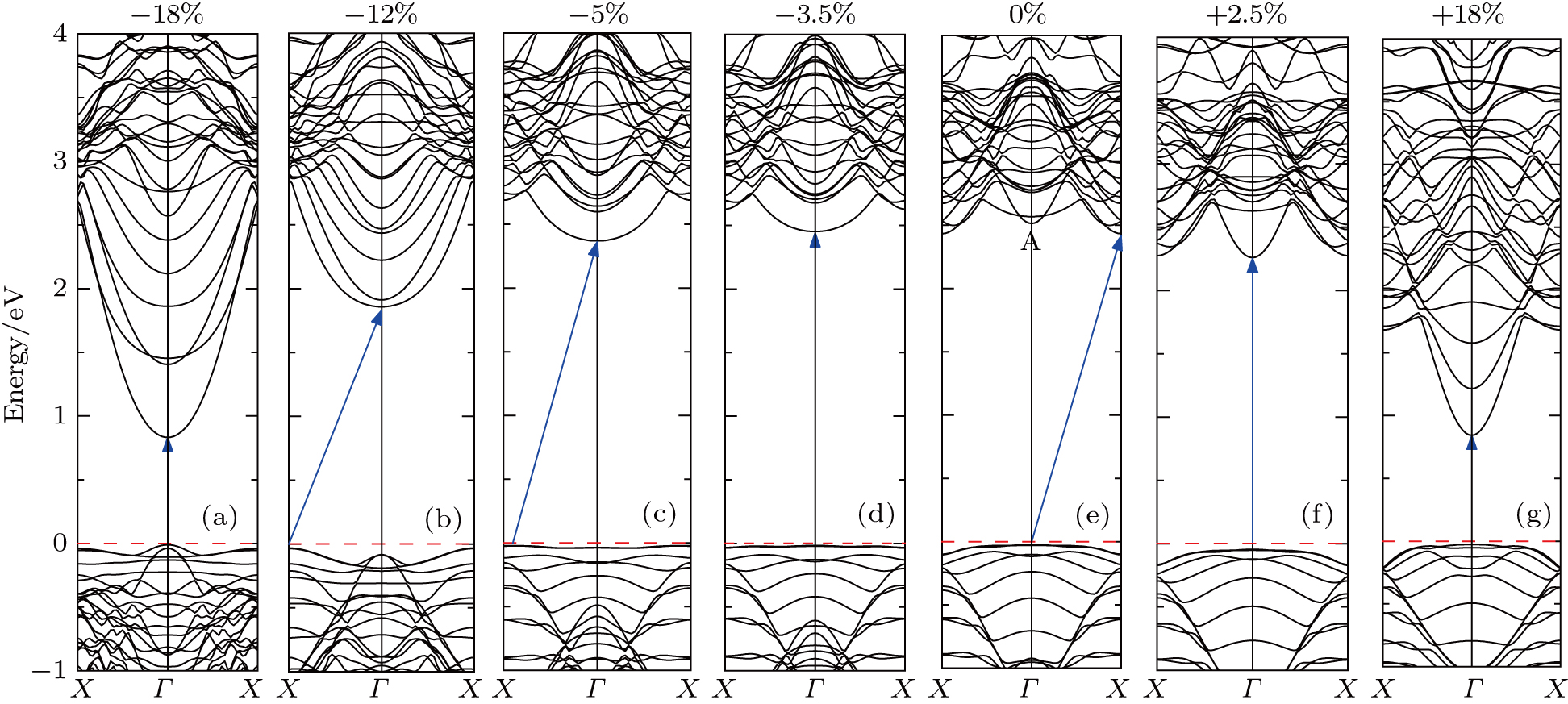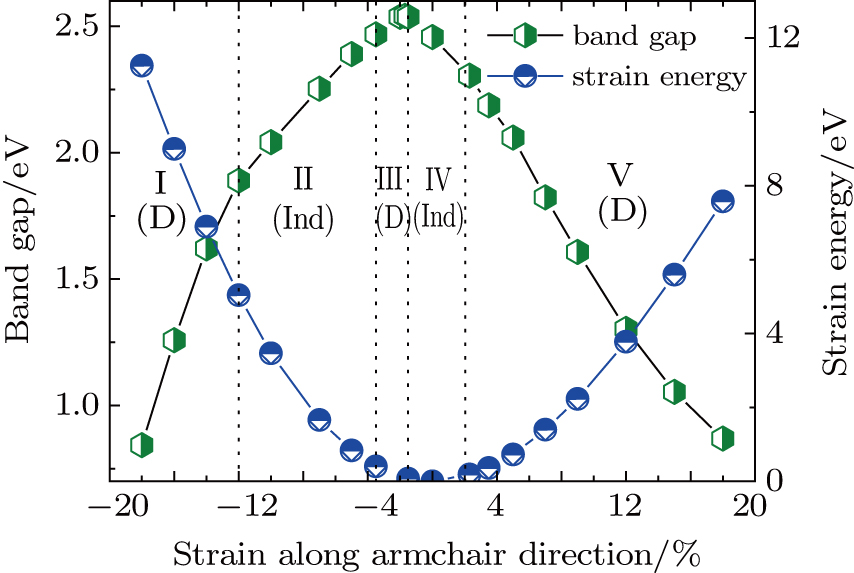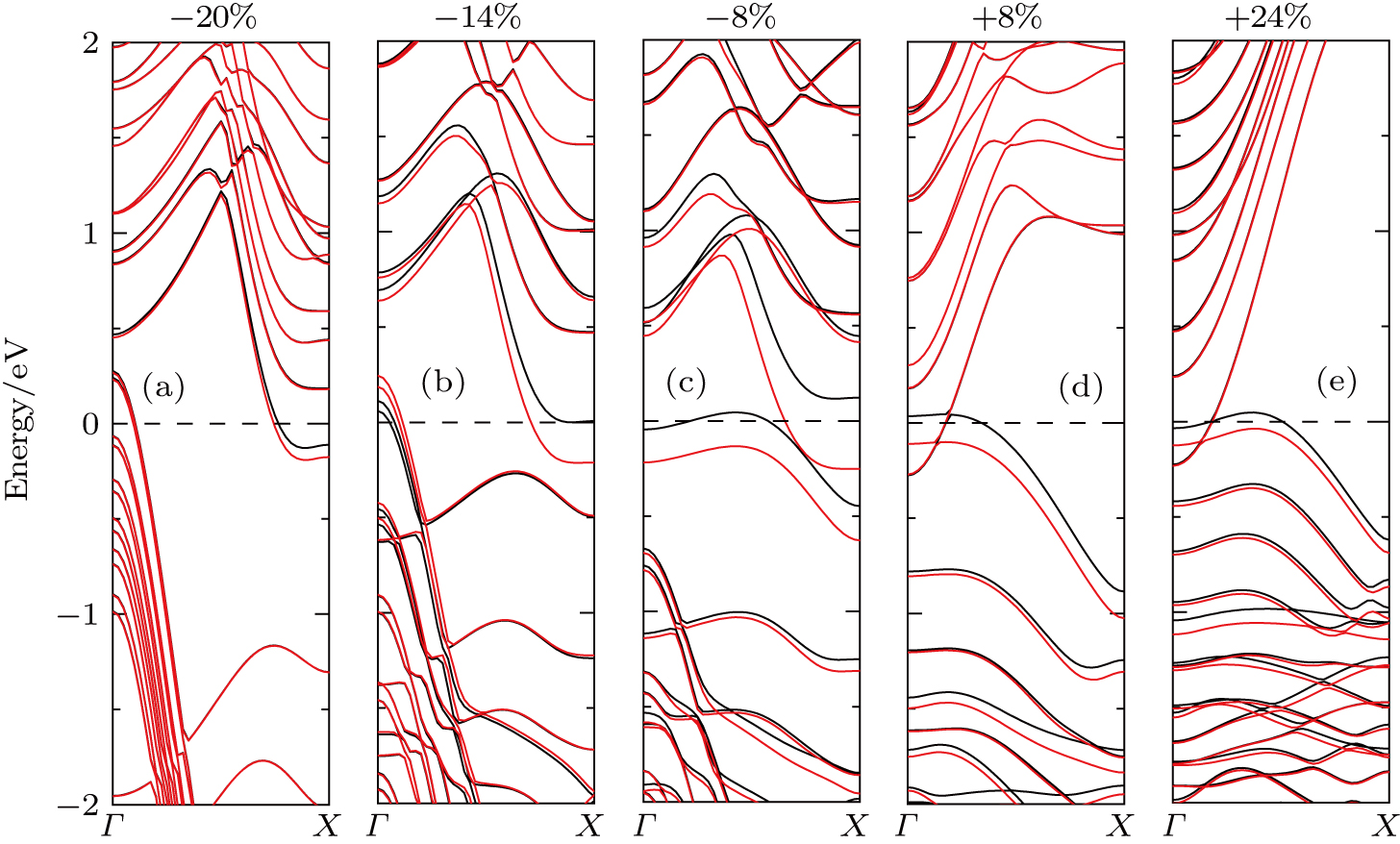† Corresponding author. E-mail:
Using first-principles calculations, we study the tailoring of the electronic and magnetic properties of gallium sulfide nanoribbons (Ga2S2NRs) by mechanical strain. Hydrogen-passivated armchair- and zigzag-edged NRs (ANRs and ZNRs) with different widths are investigated. Significant effects in band gap and magnetic properties are found and analyzed. First, the band gaps and their nature of ANRs can be largely tailored by a strain. The band gaps can be markedly reduced, and show an indirect-direct (I-D) transition under a tensile strain. While under an increasing compressive strain, they undergo a series transitions of I-D-I-D. Five strain zones with distinct band structures and their boundaries are identified. In addition, the carrier effective masses of ANRs are also tunable by the strain, showing jumps at the boundaries. Second, the magnetic moments of (ferromagnetic) ZNRs show jumps under an increasing compressive strain due to spin density redistribution, but are unresponsive to tensile strains. The rich tunable properties by stain suggest potential applications of Ga2S2NRs in nanoelectronics and optoelectronics.
Since the successful exfoliation of graphene, two-dimensional (2D) nanomaterials, such as boron nitride,[1,2] molybdenum disulfide (MoS2),[3] and others,[4–6] have attracted a great deal of attention due to their interesting physical and chemical properties. Recently, monolayer Ga2S2, as a new kind of metal chalcogenide material with a 2D honeycomb structure, was fabricated by mechanical exfoliation from the bulk, and was also successfully grown in 2D and quasi-1D forms by vapor transport techniques.[4,7,8] The Ga2S2 monolayer consists of S–Ga–Ga–S atomic layers with a Ga–Ga dimer covalently bonded to six S atoms, leading to a symmetry of 
Tunability of electronic and magnetic properties of a material by external controls, such as strain, is very beneficial for its applications in nanoelectronics and optoelectronics.[13–15] Recently, it was found that the band gap of Ga2S2 monolayer decreases near linearly with increasing tensile strain, and the effective mass of carrier exhibits a strong anisotropy and can also be effectively modulated by applying a compressive or tensile strain.[16,17] Orudzhev et al. showed that the elastic constants of the GaS layered compound increase monotonically with increasing pressure in the range of 0–20 GPa.[18] A theoretical study demonstrated that the electronic properties of GaS/GaSe heterostructures can be continuously tuned by an external strain.[19] These findings suggest that strain engineering is a simple and promising way to modulate the intrinsic physical properties of low-dimensional nanomaterials. Therefore, one may ask, what are the effects of external strains on Ga2S2NRs? How can significant modulation of their electronic and magnetic properties be achieved by applying strains? To date, the answers have not been available in the literature to the best of our knowledge.
In this work, we investigate the strain modulation of electronic and magnetic properties of Ga2S2NRs by performing first-principles DFT calculations. The elastic limits of Ga2S2NRs are firstly examined in terms of stress–strain relations. For nonmagnetic and semiconducting AGa2S2NRs within the elastic limit, the shifts of the band edges and the nature of the band gaps are investigated by analyzing the evolution of the band structure under different strains. Several critical strains are found to trigger an indirect-direct (I-D) transition. This detailed knowledge about the band gap I-D transition can be very useful for the optical applications of AGa2S2NRs. For example, a similar strain-induced I-D transition in GaAs nanowires was predicted theoretically[20,21] and observed in a recent experiment,[22] in which the luminescence of the GaAs nanowires can be switched on and off by changing the uniaxial stress applied. Besides the band gap modulation, the electron and hole effective masses in AGa2S2NRs are also found to be tunable by the strain. For ferromagnetic and metallic ZGa2S2NRs, we focus on the strain modulation of the magnetic moments.
The structures of Ga2S2NRs are initially constructed by cutting out a stripe of Ga2S2 sheet with the desired edges and widths. Following the previous convention,[23–25] the number of dimer lines (An) or zigzag chains (Zn) across the ribbon width is used to present the width of an armchair-edged ribbon (henceforth denoted as An-Ga2S2NR) (see Fig. 



 | Fig. 1. (color online) Top and side views of the atomic structures of Ga2S2NRs with hydrogen-passivated armchair (a) and zigzag (b) edges. |
The atomic structure relaxation and electronic structure calculations are carried out in Kohn–Sham DFT as implemented in the Vienna ab initio simulation package (VASP).[26] The projector augmented wave method (PAW)[27] is used to describe the ion–electron interaction. Plane waves with a kinetic energy cutoff of 600 eV are used to expand the wave functions. The electron exchange and correlation are treated by the generalized gradient approximation (GGA)[28] in the version of Perdew–Burke–Ernzerhof (PBE).[29] The 4s24p1 electrons of Ga and 3s23p4 electrons of S are treated as the valence electrons. Periodic boundary conditions (PBC) are employed for the infinitely long nanoribbon systems and a vacuum space of 15 Å in each direction perpendicular to the ribbon is used to eliminate the interactions between the periodic images. The atomic structures of the systems are relaxed with the conjugate gradient method until the force on each atom is less than 0.01 eV/Å. For the structure optimization, a Monkhorst–Packs k-mesh of 1 × 1 × 21 is used for the Brillouin zone (BZ) sampling. The band structures are presented by 45 k points. The results for free-standing Ga2S2NRs given by the present computational parameters are consistent with those in the previous calculations.[12]
Generally, the elastic limit of a crystal is defined as the sustainable maximum strain under tension or compression. When the strain of the crystal is larger than the elastic limit, the deformation of the crystal is irreversible, which is called mechanical failure. In order to estimate the elastic limits of Ga2S2NRs, we first calculate the stress (force) of Ga2S2NRs as a function of strain by using the method described in Refs. [30] and [31], which was originally proposed for three-dimensional crystals. Considering that the thickness of a Ga2S2NR is not well defined, we present the stress using force instead of force per unit area.[32] For AGa2S2NRs, four widths (An, n = 4, 5, 12, and 13) are considered, while for ZGa2S2NRs, which are all metallic regardless of the ribbon width, only one width (Z6-Ga2S2NR) is considered. The calculated stress–strain relations are presented in Fig.
Our calculations show that the AGa2S2NRs with different widths undergo a series of band gap I-D transitions under an increasing strain from −18% to +18%. As an example, the band structures of A13-Ga2S2NR under various strains are given in Fig. 




 | Fig. 3. (color online) Strain-induced indirect-direct band gap transition in A13-Ga2S2NR. The arrows are from VBM to CBM. |
We note that the Kohn–Sham DFT calculations usually underestimate band gaps of semiconductors because of the lacking of the derivative discontinuity in the energy functionals. However, the shapes of the frontier valence band and conduction band are usually reliable and are close to the result from many-body quasi-particle calculations. Our work here is focused on the trend in the band gap variation under different strains instead of the absolute values of the band gap, therefore the results can be expected to be meaningful. This justification is also supported by the previous calculations using the hybrid functional HSE06 and PBE, showing consistent strain-induced effects on the band structures.[39]
In Fig.
The effective masses of electron and hole in the ribbon direction are determined by 









The present calculations and a previous work[12] show that ZGa2S2NRs are ferromagnetic and metallic. Here we investigate the strain effects on the magnetic properties of ZGa2S2NRs by taking Z6-Ga2S2NR as an example. Strains ranging from −20% to +24% are considered. The calculated band structures under various strains (Fig. 


Next let us look at the strain effects on the magnetic moment, as shown in Fig. 




Finally, we would like to mention that all the strains investigated are within the elastic limit and are fully reversible. To further confirm this, we calculate the strain energy per atom, 

Using first-principles calculations, we have studied systematically the strain effects on the electronic and magnetic properties of Ga2S2NRs with different edge structures and widths. Significant effects in band gap and magnetic properties are found and analyzed. Our findings are as follows.
Within the elastic limit, the stress–strain relations are linear for AGa2S2NRs under moderate strains but are nonlinear for ZGa2S2NRs. Similar to GNRs, ZGa2S2NRs possess larger elastic limits than AGa2S2NRs, and the predicted values are close to those found in other quasi-1D materials such as GNRs and silicene nanoribbons. This may imply applications in flexible display.
The band gaps and their nature of AGa2S2NRs can be largely tailored by a strain. An increasing tensile strain will reduce the band gap, while an increasing compressive strain will first increase the band gap and then rapidly decrease it due to the switch of the CBM from X to Γ. The overall change in band gap can be from ∼ 2.5 eV to ∼ 0.85 eV within the elastic limits. Under a tensile strain, the band gap shows an indirect-direct transition, while under an increasing compressive strain, it undergoes a series transitions of I-D-I-D. At the first I-D transition, degenerate valleys of CBM will be created, which suggests potential applications in valleytronics and/or photocatalysis. Five strain zones with distinct band structures and their boundaries are identified. Zones II and IV should be avoided for optical applications. In addition, we demonstrate that the strain can also dramatically tune the effective masses of carriers, thus, can be used to modify the carrier mobilities of AGa2S2NRs in nanoelectronic applications.
The FM states of ZGa2S2NRs are still favorable under strains, though extremely large compressive strains (> −14%) will turn them to an AFM phase. The magnetic moments of (ferromagnetic) ZGa2S2NRs show jumps under an increasing compressive strain due to spin density redistribution, but are unresponsive to tensile strains. A moderate compressive strain (−2% to −12%) will significantly enhance the magnetic moment and the FM stability. Overall, the rich tunable properties by strain suggest potential applications of Ga2S2NRs in nanoelectronics and optoelectronics.
| [1] | |
| [2] | |
| [3] | |
| [4] | |
| [5] | |
| [6] | |
| [7] | |
| [8] | |
| [9] | |
| [10] | |
| [11] | |
| [12] | |
| [13] | |
| [14] | |
| [15] | |
| [16] | |
| [17] | |
| [18] | |
| [19] | |
| [20] | |
| [21] | |
| [22] | |
| [23] | |
| [24] | |
| [25] | |
| [26] | |
| [27] | |
| [28] | |
| [29] | |
| [30] | |
| [31] | |
| [32] | |
| [33] | |
| [34] | |
| [35] | |
| [36] | |
| [37] | |
| [38] | |
| [39] | |
| [40] | |
| [41] |






